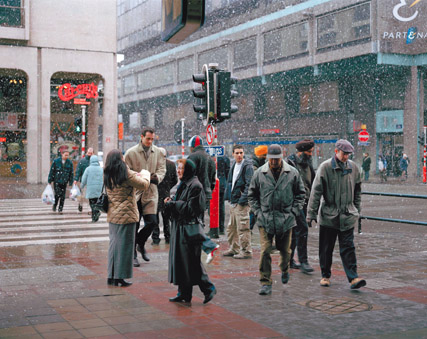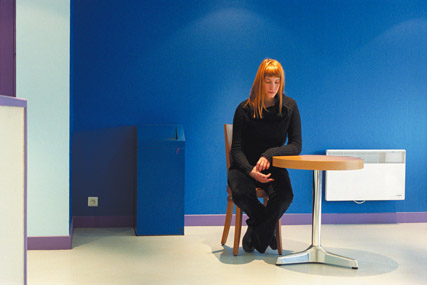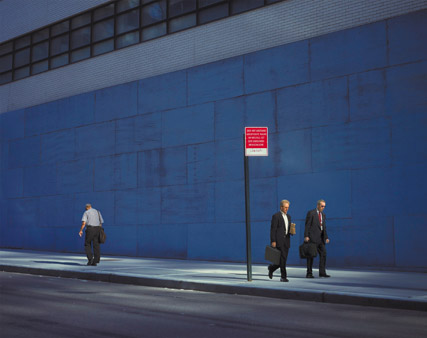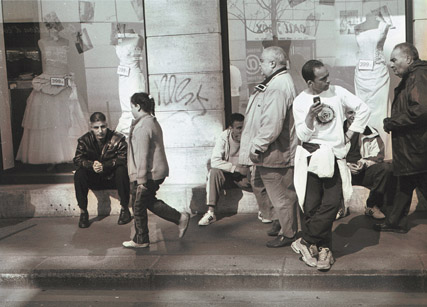the body in the city in the picture
keith gallasch & virginia baxter on dynamic still lives

Sébastien Camboulive, Extrait de la limite pluie-neige, 2005
IN 2006 LYON’S BIENNALE DE LA DANSE PARTNERED LYON SEPTEMBRE DE LA PHOTOGRAPHIE, AN EXHIBITION SPREAD THROUGH 32 GALLERIES AND OTHER VENUES ACROSS CITY AND SUBURBS. WE MANAGED TO EXPERIENCE ABOUT A QUARTER OF IT, ENGROSSED WITH PHOTOGRAPHERS EXPLOITING THE PAINTERLY POTENTIALS OF THE DIGITAL, CAPTURING EVERYDAY HUMAN MOVEMENT IN UNEXPECTED, SOMETIMES DANCERLY MOVES IN PUBLIC SPACES AND RECORDING THE GROWING CROSS-CULTURAL COMPLEXITY OF CITY LIFE.
At the Maison de la Danse, Didier Grappe seems to shoot from the waist so that the weight of the image leans toward the legs and feet of his Hamburg street subjects as they set off in different directions, or form lines, advancing on the photographer with a bounce in their step. Sébastien Camboulive’s images capture pedestrians mid-movement, clustered at the centre or the edge of intersections and all moving in different directions. One or two of them have stopped as the others dance on. Camboulive’s large format series offers a strong aesthetic take on the social kinetics of crossing the street. His recurrent choice of the same kinds of moment and space suggests a loose visual choreography, the thin line between artifice and the everyday.

Laure Bertin, Sans titre, 2004-2005
Laure Bertin’s small images recall, without being imitative, the paintings of Edward Hopper. They have the same sense of bodies caught in moments of stillness amidst distinctive colours and in unremarkable contemporary city settings—a girl at a table against a blue wall that perhaps suits her mood; a man framed in a doorway; a girl standing in front of a shop window in which we see the street, a tree, power poles and the girl herself reflected, framed by yellow columns and red walls.
In the same show, Aurélie Haberey offers a mysterious series called Les Secrets in which people disappear or crawl into foliage with hints of evasion or illicit behaviour, but mostly of merging. Pauline Rühl-Saur’s ghost figures are captured moving while seated on highly coloured furniture in public spaces—shades of the works of Australian photo media artists, Darren Siwes and Merilyn Fairskye.

Mona Breede, Distance 1, 2005
Painterly digital realism reaches its apotheosis in the work of Mona Breede, L’Arriere-Plan de L’Existence, at the Lyon Goethe Institut. She too does street scenes but they have an epic, wide screen quality portraying contemporary street life, a multicultural populace, the overpowering presence of advertising and the geometries of public and architectural space.
In Distance 1, two businessmen are caught in mid-step, behind them a man in a shirt, head down moves in the opposite direction. The red street sign between them translates as “The most important distance in the world is the distance between people. Law Department.” People appear etched, like animated still lives moving on a background of solid colour and sharply defined shadow. Can any reality be this sharp? In Distance 2, on the same street, the subjects are Asian. The works have the peculiar power of photography and painting hybridised—and not kin to photorealism.
Breede’s New York series of people walking against a low, less than familiar New York skyline are very narrow, long photographs with an even more painterly intensity. The work runs around 3 walls in long strips. These also have a slightly Hopperish feel, hard edged but soft, with a luminosity that might almost be regarded as nostalgic if its subjects are utterly contemporary. A similar approach is applied to a rich ethnic mix of pedestrians captured in a German street against a graffitied wall and a blue sky, with an even more pronounced flattening of distance.
Efrat Shvily’s black and white photographs at Espace Arts Plastiques de Venissieux are of almost completed Israeli settlements set up on Palestinian land during the first Intifada and awaiting their new inhabitants. They evoke a terrible feeling of artificiality and imposition accentuated by their monochromatic suggestion of other just as problematic times. The new settlements already look like ghost towns.
Centre Sociale Bonnefoi is a community centre in an area of Lyon where descendants of Algerian immigrants live. We met the photographer Ghislaine Hamid whose work was on display, large transparencies attached to the internal windows of the building so that they could be seen or not, as people wished. Image-making in Islamic culture was at issue here. Hamid had decided to document the all male Algerian gathering place in a nearby public space—a large circular road with open meeting space in the middle and shops and offices around the edge. She said she took the photographs so that local women could see what the men got up to in a mix of long shots, portaits and clusters of movement, like the one we’ve reproduced here outside a wedding dress shop.

Ghislaine Hamid, Les hommes debout, 2006
The project took Hamid a year. Because she was a woman with a camera she had to gain the trust of the men; she had to understand that this public place was a community space and how it worked—the young men gathering in the centre, others further out. The women told Hamid that they liked the photos for the unthreatening ease revealed in their male friends and relatives, but commented, “We don’t have time to sit around like the men.”
Our final stop is at the magnificent Musée d’Art Contemporain, part of a Renzo Piano creation using his favourite terracotta tile that houses a cinema, shops, restaurants and a conference centre as well as the infinitely flexible gallery—every wall can move.

Sébastien Camboulive, Extrait de la limite pluie-neige, 2005
By way of monumental Robert Morris installations and through a wonderful exhibition by young Japanese artists—Aya Takano, Cho Ao Shima, Aosha—working exquisitely out of manga, anime and the Japanese print tradition, we are guided to the works of too many photographers to absorb before we fly out of Lyon. We witness an incredible range of responses to people in the built environment from vivid scenes of a street bazaar in India to Florian Ebner’s enigmatic studies of young European men caught in casual movement, and David Moziconacci’s Asian workers in New York at work and asleep on factory floors, to Valerie Jouve’s immaculately detailed but nonetheless spontaneous images of people she’s approached in the street. Occasionally we sight surreal images, but there is a larger sense that the everyday is strange enough or, as in Breede and others, that the everyday can be heightened just enough to bring home its otherness. Elsewhere (Geraldine Lay and Christian Buffa) it’s to be found in works that drop background into near black making their subjects luminous, or disappear depth of field.
We relucantly drag ourselves away from a captivating exhibition to enter our own little still lives in the demanding if sometimes dance of airport queuing and airline travel.
Our thanks to artist and curator Nicolas Garait for guiding us through aspects of Lyon Septembre de la Photographie.
Lyon Septembre de la Photographie, la region humaine, des corps dans la ville, Sept 15-Nov 4, www.lebleuduciel.net
RealTime issue #76 Dec-Jan 2006 pg. 6






